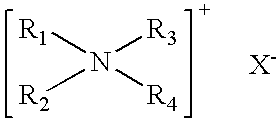Topical anti-microbial compositions
a technology of antimicrobial compositions and compositions, applied in the field of topical antimicrobial compositions, can solve the problems of limited use of these compounds, limited use of polyvalent metal salts of pyrithione that can be added to commercial products, and environmental concerns, and the amount of pyrithione salts that may be added is further limited by toxicological concerns
- Summary
- Abstract
- Description
- Claims
- Application Information
AI Technical Summary
Benefits of technology
Problems solved by technology
Method used
Image
Examples
example 1
The Effect of Combining ZPT with Metal Ions on the Minimum Inhibitory Concentration (MIC) of Metal Ions
[0277]Experiments were conducted to investigate the efficacy of the composition of the present invention to inhibit the survival, growth, and proliferation of microorganisms in topical compositions. The test microorganism was Malassezia furfur. The testing principle employed, Minimum Inhibitory Concentration (MIC), is discussed below, and the results are tabulated in Table 1.
[0278]The Minimum Inhibitory Concentration is indicative of anti-fungal efficacy. Generally, the lower the value of the composition, the better its anti-fungal efficacy, due to increased inherent ability of the anti-dandruff agent to inhibit the growth of microorganisms.
[0279]Malassezia furfur was grown in a flask containing mDixon medium (see E. Gueho, et al. Antoinie Leeuwenhoek (1996), no. 69, 337–55, which description is incorporated by reference herein). Dilutions of solubilized anti-microbial active were ...
example 2
The Effect of Metal Ions on the Kill Rate Results of Zinc Pyrithione
[0291]Experiments were conducted to investigate the efficacy of the composition of the present invention to inhibit the survival, growth, and proliferation of microorganisms in topical compositions. The test microorganism was Malassezia furfur. The testing principle employed, Kill Rate Test (KRT), is discussed below, and the results are tabulated in Tables 2(a) and 2(b).
[0292]The Kill Rate Test (KRT) results are indicative of anti-fungal efficacy. Generally, the greater the inhibition of fungal growth in this test, the better the anti-fungal efficacy of the compound(s) tested.
[0293]A flask containing mDixon broth medium (see Gueho, et al. Antoinie Leeuwenhoek (1996), no. 69, 337–55, which description is incorporated by reference herein) was inoculated with Malassezia furfur. Specific concentrations of active(s) were then added to the flask Samples were then withdrawn from the flask at specified time points, diluted ...
examples 3 through 26
Topical Compositions
[0314]The compositions illustrated in Examples 3 through 26 illustrate specific embodiments of the topical anti-microbial compositions of the present invention, but are not intended to be limiting thereof.
[0315]All exemplified compositions can be prepared by conventional formulation and mixing techniques. Component amounts are listed as weight percents and exclude minor materials such as diluents, filler, and so forth. The listed formulations, therefore, comprise the listed components and any minor materials associated with such components. As used herein, “minors” refers to those optional components such as preservatives, viscosity modifiers, pH modifiers, fragrances, foam boosters, and the like. As is apparent to one of ordinary skill in the art, the selection of these minors will vary depending on the physical and chemical characteristics of the particular ingredients selected to make the present invention as described herein. Other modifications can be undert...
PUM
| Property | Measurement | Unit |
|---|---|---|
| Fraction | aaaaa | aaaaa |
| Fraction | aaaaa | aaaaa |
| Fraction | aaaaa | aaaaa |
Abstract
Description
Claims
Application Information
 Login to View More
Login to View More - R&D
- Intellectual Property
- Life Sciences
- Materials
- Tech Scout
- Unparalleled Data Quality
- Higher Quality Content
- 60% Fewer Hallucinations
Browse by: Latest US Patents, China's latest patents, Technical Efficacy Thesaurus, Application Domain, Technology Topic, Popular Technical Reports.
© 2025 PatSnap. All rights reserved.Legal|Privacy policy|Modern Slavery Act Transparency Statement|Sitemap|About US| Contact US: help@patsnap.com



